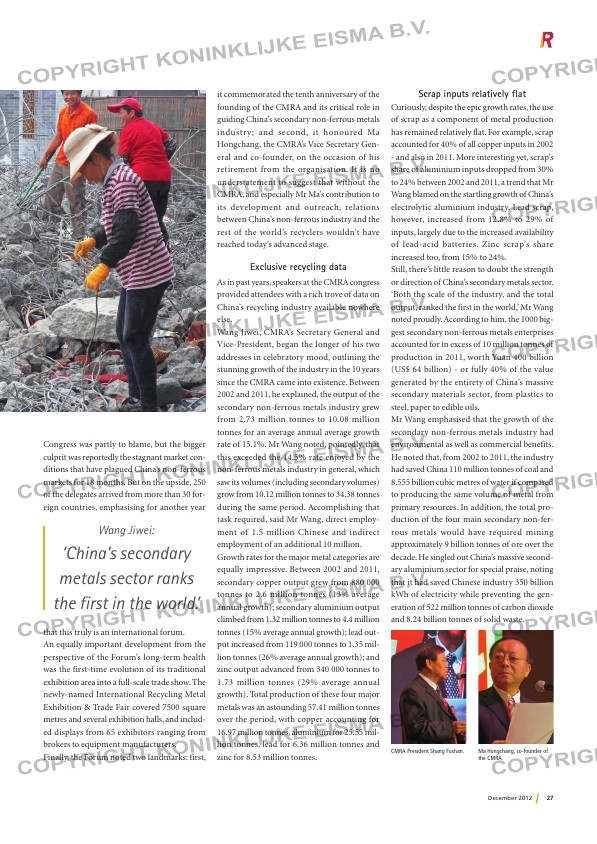Page 27 from: December 2012

27December 2012
Congress was partly to blame, but the bigger
culprit was reportedly the stagnant market con-
ditions that have plagued China’s non-ferrous
markets for 18 months. But on the upside, 250
of the delegates arrived from more than 30 for-
eign countries, emphasising for another year
that this truly is an international forum.
An equally important development from the
perspective of the Forum’s long-term health
was the first-time evolution of its traditional
exhibition area into a full-scale trade show. The
newly-named International Recycling Metal
Exhibition & Trade Fair covered 7500 square
metres and several exhibition halls, and includ-
ed displays from 65 exhibitors ranging from
brokers to equipment manufacturers.
Finally, the Forum noted two landmarks: first,
it commemorated the tenth anniversary of the
founding of the CMRA and its critical role in
guiding China’s secondary non-ferrous metals
industry; and second, it honoured Ma
Hongchang, the CMRA’s Vice Secretary Gen-
eral and co-founder, on the occasion of his
retirement from the organisation. It is no
understatement to suggest that without the
CMRA, and especially Mr Ma’s contribution to
its development and outreach, relations
between China’s non-ferrous industry and the
rest of the world’s recyclers wouldn’t have
reached today’s advanced stage.
Exclusive recycling data
As in past years, speakers at the CMRA congress
provided attendees with a rich trove of data on
China’s recycling industry available nowhere
else.
Wang Jiwei, CMRA’s Secretary General and
Vice-President, began the longer of his two
addresses in celebratory mood, outlining the
stunning growth of the industry in the 10 years
since the CMRA came into existence. Between
2002 and 2011, he explained, the output of the
secondary non-ferrous metals industry grew
from 2.73 million tonnes to 10.08 million
tonnes for an average annual average growth
rate of 15.1%. Mr Wang noted, pointedly, that
this exceeded the 14.5% rate enjoyed by the
non-ferrous metals industry in general, which
saw its volumes (including secondary volumes)
grow from 10.12 million tonnes to 34.38 tonnes
during the same period. Accomplishing that
task required, said Mr Wang, direct employ-
ment of 1.5 million Chinese and indirect
employment of an additional 10 million.
Growth rates for the major metal categories are
equally impressive. Between 2002 and 2011,
secondary copper output grew from 880 000
tonnes to 2.6 million tonnes (13% average
annual growth); secondary aluminium output
climbed from 1.32 million tonnes to 4.4 million
tonnes (15% average annual growth); lead out-
put increased from 119 000 tonnes to 1.35 mil-
lion tonnes (26% average annual growth); and
zinc output advanced from 340 000 tonnes to
1.73 million tonnes (29% average annual
growth). Total production of these four major
metals was an astounding 57.41 million tonnes
over the period, with copper accounting for
16.97 million tonnes, aluminium for 25.55 mil-
lion tonnes, lead for 6.36 million tonnes and
zinc for 8.53 million tonnes.
Scrap inputs relatively flat
Curiously, despite the epic growth rates, the use
of scrap as a component of metal production
has remained relatively flat. For example, scrap
accounted for 40% of all copper inputs in 2002
– and also in 2011. More interesting yet, scrap’s
share of aluminium inputs dropped from 30%
to 24% between 2002 and 2011, a trend that Mr
Wang blamed on the startling growth of China’s
electrolytic aluminium industry. Lead scrap,
however, increased from 12.8% to 29% of
inputs, largely due to the increased availability
of lead-acid batteries. Zinc scrap’s share
increased too, from 15% to 24%.
Still, there’s little reason to doubt the strength
or direction of China’s secondary metals sector.
‘Both the scale of the industry, and the total
output, ranked the first in the world,’ Mr Wang
noted proudly. According to him, the 1000 big-
gest secondary non-ferrous metals enterprises
accounted for in excess of 10 million tonnes of
production in 2011, worth Yuan 400 billion
(US$ 64 billion) – or fully 40% of the value
generated by the entirety of China’s massive
secondary materials sector, from plastics to
steel, paper to edible oils.
Mr Wang emphasised that the growth of the
secondary non-ferrous metals industry had
environmental as well as commercial benefits.
He noted that, from 2002 to 2011, the industry
had saved China 110 million tonnes of coal and
8.555 billion cubic metres of water if compared
to producing the same volume of metal from
primary resources. In addition, the total pro-
duction of the four main secondary non-fer-
rous metals would have required mining
approximately 9 billion tonnes of ore over the
decade. He singled out China’s massive second-
ary aluminium sector for special praise, noting
that it had saved Chinese industry 350 billion
kWh of electricity while preventing the gen-
eration of 522 million tonnes of carbon dioxide
and 8.24 billion tonnes of solid waste.
Ma Hongchang, co-founder of
the CMRA.
CMRA President Shang Fushan.
Wang Jiwei:
‘China’s secondary
metals sector ranks
the first in the world.’
RI_10-CMRA.indd 27 30-11-12 14:26



